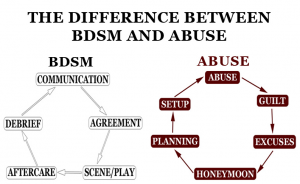The relationship between kink and domestic violence can get really, really, really fuzzy depending on who you ask. You don’t have to throw the stone very far to find folks who misunderstand the kink community and might quickly make a judgment that a BDSM relationship is abusive and violent. You also don’t have to look very far to find someone in the kink community that has had a previous kink relationship that they would define as “abusive” or “violent”.
So this topic can be VERY confusing and very MISUNDERSTOOD. I would caution everyone to be careful in making a judgment based on your own views of what you THINK you might believe, at the same time provide someone you have concern about with a respectful view of the facts and what you are noticing.
Based on a recent training at SAFE Austin (www.SAFEaustin.org) on “Discerning Domestic Violence” for therapists and mental health professionals, I’m going to apply some concepts around domestic violence and how these might be similar to kink relationships and how they might be different.
Before I do that, I want to explain just a few concepts about kink that are essential to understanding how kink relationships may mimic aspects of abusive relationships or domestic violence but ARE different. I call these the Three C’s of Kink and Safety.
- The number one rule of a kink relationship is CONSENT. That consenting adults who agree to some terms and limits (see contracts) who continuously review consent can kind of do what they want and express themselves how they chose to. Domestic violence is inherently non-consensual, but it doesn’t always appear that way.
- Another very safe concept in BDSM/Kink is COMMUNITY. The BDSM community is often a great checks and balances to its own members and the acts of its members. Education, support, training, and mentorship is available within the community.
- CONTRACTS are another great way that people in the kink community ensure that their lifestyle avoids some of the vulnerabilities of domestic violence. Generally, you don’t
This great graphic came from CARAS (www.carasresearch.org), an organization dedicated to promoting alternative sexualities research and providing education for mental health professionals.
You’ll see in this graphic that there is a distinct difference between the cycle of abuse and the cycle of a BDSM scene or relationship, and the basis of it is CONSENT.
Domestic violence is a PATTERN OF BEHAVIOR that is used to attempt to control, manipulate, or demean an intimate partner using tactics such as physical and emotional abuse, intimidation, economic abuse, and reproductive coercion. It is obviously different from a consensual relationship between two adults that might have aspects of manipulation, control, humiliation, and demeaning behaviors and acts based on erotic play.
In domestic violence, the abusive partner may use coercion, intimidation, emotional abuse, threats, isolation, economic abuse and/or the children to control his or her partner. He or she also minimizes, denies, and blames the partner for their own behavior. The core issue for the abused is to be in control of the relationship in order to have his or her needs met. If the aforementioned tactics don’t work, then the abuser enforces their threats with physical and/or sexual violence.
 In a kink relationship, the roles of the partners are pre-established and communicated as well as regularly re-evaluated. Control may be a mechanism of erotic play, but also may be fluid between both partners based on their communication and contracting agreement.
In a kink relationship, the roles of the partners are pre-established and communicated as well as regularly re-evaluated. Control may be a mechanism of erotic play, but also may be fluid between both partners based on their communication and contracting agreement.
Domestic violence is a COMPLEX situation, and so is kink. If you think you might be a victim of domestic violence, regardless if you are in a kink relationship or not, get yourself to a safe place and call the National Domestic Violence Hotline at 1-800-799-7233 | 1-800-787-3224 (TTY). They also have live chat feature on their website.
If you aren’t sure if you are or not, check in with your community and let them know your concerns. A good way of checks and balances in the kink lifestyle is talking to others about what you are feeling and going through. You can also contact me at the below link to set up an appointment to discuss what you are feeling and thinking.
Looking for more information, check out this links:
http://www.ncsfreedom.org/resources/50-shades
www.carasresearch.org



